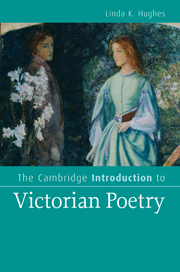Book contents
- Frontmatter
- Contents
- List of figures
- Preface
- Acknowledgments
- Editions cited
- Introducing Victorian poetry
- Part I The forms of Victorian poetry
- Part II The rhetoric of Victorian poetry
- Introduction to Part II
- 4 Poetry, technology, science
- 5 Poetry and religion
- 6 Poetry and the heart's affections
- 7 Poetry and empire
- 8 Poetic liberties
- 9 Resisting rhetoric: art for art's sake
- Part III Coda Close readings
- Glossary
- Notes
- Further reading
- Index
- Cambridge Introductions to Literature
9 - Resisting rhetoric: art for art's sake
Published online by Cambridge University Press: 05 June 2012
- Frontmatter
- Contents
- List of figures
- Preface
- Acknowledgments
- Editions cited
- Introducing Victorian poetry
- Part I The forms of Victorian poetry
- Part II The rhetoric of Victorian poetry
- Introduction to Part II
- 4 Poetry, technology, science
- 5 Poetry and religion
- 6 Poetry and the heart's affections
- 7 Poetry and empire
- 8 Poetic liberties
- 9 Resisting rhetoric: art for art's sake
- Part III Coda Close readings
- Glossary
- Notes
- Further reading
- Index
- Cambridge Introductions to Literature
Summary
Waste not your Hour, nor in the vain pursuit
Of This and That endeavour and dispute;
Better be jocund with the fruitful Grape
Than sadden after none, or bitter, Fruit.
Edward FitzGerald, The Rubáiyát of Omar Khayyám (1872)For that dim brow and lingering hand
Come from a more dream-heavy land,
A more dream-heavy hour than this.
W. B. Yeats, “He Remembers Forgotten Beauty”If aestheticism mandated poetry's suspension of religious and moral purpose in favor of form and beauty as ends in themselves, newer attitudes toward sexual relations, degeneration, and the artistic temperament driven by Darwinian science and commodity culture intensified this development at century's end. Evolutionary theory, for example, prompted debate about which elements in human nature – and British culture – were fittest to survive. In “The New Hedonism” Grant Allen argued that full “self-development” meant that the “sex instinct,” which drove humans to the highest levels of intellectual and aesthetic creativity, should be elevated over “self-sacrifice.” Contrary to this optimistic coupling of sexual liberty and artistic excellence, Max Nordau and others linked contemporary art to “degenerates” characterized by inability to tell right from wrong and male “emotionalism”: “a commonplace line of poetry or of prose sends a shudder down his back; he falls into raptures before indifferent pictures or statues.”
Nordau might be describing the poet-aesthete Bunthorne in Gilbert and Sullivan's comic opera Patience (1881); it was to promote Patience in America that the D'Oyly Carte opera company hired Oscar Wilde (on whom Bunthorne was partly based) to tour America and speechify about aestheticism while sporting velvet knee breeches and holding a lily.
- Type
- Chapter
- Information
- The Cambridge Introduction to Victorian Poetry , pp. 239 - 258Publisher: Cambridge University PressPrint publication year: 2010

